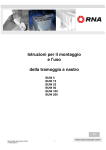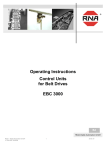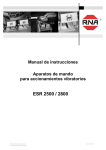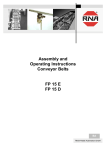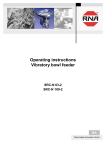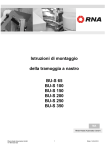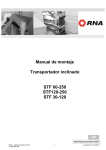Download Assembly and Operating Instructions Bulk Hopper Conveyor
Transcript
Assembly and Operating Instructions Bulk Hopper Conveyor BUW BUW BUW BUW BUW BUW 5 15 25 50 100 200 BA Rhein-Nadel Automation GmbH Rhein - Nadel Automation GmbH VT-MA-BUW-GB 1 Date 25.05.2010 Contents 1 1.1 1.2 Measurements Technical specifications Connecting plan for motors Page Page Page 2 3 3 2 Safety instructions Page 4 3 Construction and function of the belt hoppers Page 6 4 4.1 4.2 Transport and assembly Transport Assembly Page Page 7 7 5 Initial start-up Page 8 6 Maintenance Page 10 7 Stockkeeping of spare parts and customer service Page 10 Declaration of incorporation as defined by Machinery directive 2006/42/CE Herewith we declare that the product is intended to be incorporated into or assembled with other machines to constitute machinery covered by this directive (or parts of it) and must not be put into service until the machinery into which it is to be incorporated has been declared in conformity with the provision of the CE machinery directive. applied harmonized standards: DIN EN 60204 T1, EN ISO 12100-1, EN ISO 12100-2, DIN EN 619, DIN EN 620 DIN EN ISO 14121-1 remarks: The product has been produced according to the Low Voltage directive 2006/95/EC. We assume that our product is to be integrated in a fixed machine. The provisions of the EMC directive 2004/108/EC has to be considered by the user. Rhein-Nadel-Automation -------------------------------Managing Director Jack Grevenstein Rhein - Nadel Automation GmbH VT-MA-BUW-GB 2 Date 25.05.2010 1. Measurements L B2 H C A B1 Type L A B1 B2 H C BU-W 5 475 450 120 125 90 145 BU-W 15 475 450 120 250 205 145 BU-W 25 525 500 150 280 235 145 BU-W 50 825 800 250 380 235 145 BU-W 100 1025 1000 300 430 265 145 BU-W 200 1025 1000 300 430 470 145 1.1. Technical specifications Belt hoppers of the 3-phase type Type BU-W 5 BU-W15 BU-W25 BU-W50 BU-W100 BU-W200 max. filling volume in litres 5 15 25 50 100 200 max. filling weight (kg) 15 50 70 80 100 100 Belt speed 2m/min Nominal voltage 230/400 V Current consumption (A) Motor current (W) Control system: protective motor switch with linkage Motor position (W) Rhein - Nadel Automation GmbH VT-MA-BUW-GB 0.37 90 We recommend our EBB 1ZDS In the standard version, the motor is positioned on the right (in the moving sense) 3 Date 25.05.2010 Belt hoppers of the AC type Type BU-W 5 BU-W15 BU-W25 BU-W50 BU-W100 BU-W200 max. filling volume in litres 5 15 25 50 100 200 max. filling weight (kg) 15 50 70 80 100 100 Belt speed 2m/min Nominal voltage 230V Current consumption (A) 0.64 Motor current (W) Control system: protective motor switch with linkage Motor position (W) 90 We recommend our EBB 1ZS In the standard version, the motor is positioned on the right (in the moving sense) 1.2. Connecting data for motors Connecting plan for 3-phase motor 2 Connecting plan for capacitor motor Safety instructions We have taken great care in the planning and production of our conveyor belts to guarantee trouble-free and safe operation. You too can make an important contribution towards job safety by reading these short operating instructions through completely before the initial start-up. Always observe the safety instructions! Attention This warning sign indicates safety instructions. Non-observance of these warnings can result in serious injuries or death! Caution This warning sign indicates safety instructions. Non-observance of this warning can result in serious personal injuries or damage to property! Note This hand shows that there are Notes to give you helpful hints for operating the conveyor belts. Make sure that all persons working with or at this machine also read the following safety instructions attentively and observe them. Rhein - Nadel Automation GmbH VT-MA-BUW-GB 4 Date 25.05.2010 These operating instructions only apply to the machine types mentioned on the title sheet. The instructions must always be available in the place of operation of the conveyor belt. When using the conveyor belt in moist or wet surroundings (humid area), one must make sure that the required type of protection is met. Note For full information about the entire range of control boxes, please refer to “Control Boxes” in the operating instructions. The initial start-up, conversion, maintenance and repair work may only be carried out by qualified and authorised staff (see also “Requirements for the User” in this chapter). During assembly, maintenance and repair work, the conveyor belt has to be all-pole disconnected from the mains in accordance with the Association of German Electrotechnical Engineers (VDE). Work on electrical equipment may only be carried out by a specialist electrician or by a person instructed in electrotechnics under the supervision of a specialist electrician according to the electrotechnical regulations. Attention There is the risk of injury and danger through electric shock! • Users and operators must take care that only authorised staff works at the conveyor belt. • Changes that restrict safety must be reported to the operator immediately. • The conveyor belt may only be operated if it is in perfect condition. • The conveyor belt may only be operated in the sense of its intended use. • Please observe the safety regulation VBG 10 for continuous conveyors and VBG 4 for electrical equipment and operating material. • Make sure that the protective earthing of the power supply is in perfect condition. • It is absolutely forbidden to operate the conveyor belt without its casing and protective covers (chain drive). • The gap at the drawing-in points of the belt may not be wider than 4 mm, otherwise there is a drawing-in hazard. Should the gap become wider after adjusting the belt, the protective collar also has to be readjusted. Intended use The belt hopper is intended to be used for storing and transporting material to be conveyed. This material must have a smallest lateral length of at least 5 mm. Caution Smaller parts may get under the belt, causing damage or failure to the conveyor belt. With standard belts, the material to be conveyed has to be dry, clean and not have sharp edges. For the transport of sharp-edged, oily, wet or hot (> 70°C) material, special belts have to be used. The material to be conveyed must not fall onto the conveyor belt from a greater height. The maximum permissible impact energy is 0.1 J. In case of doubt, please ask the manufacturer. The hopper belts are designed for horizontal transport with maximum load. A slight inclination of the conveying level is possible in particular cases. In such a particular case, please ask the manufacturer what is possible. Rhein - Nadel Automation GmbH VT-MA-BUW-GB 5 Date 25.05.2010 Please refer to Technical Data (Chapter 1) for the permissible belt loading. Noise emission The continuous sound level is maximum 70 dB(A). The transport of material or the quality of the belt can produce a higher noise level. For these exceptions, you can ask your manufacturer about noise abatement measures. Requirements for the user Initial start-up, conversion work as well as maintenance and repair work may only be carried out by qualified and authorised staff. We differentiate between four levels of qualification: Qualified staff Qualified staff are persons acquainted with the installation, assembly, initial start-up and operation of the conveyor belt. They have an adequate qualification for their job. Authorised staff is qualified staff that has been made familiar with a clearly defined duty by the operator of the conveyor belt. Specialist electricians (according to IEC 364 and DIN VDE 0105 Part 1) are persons who, thanks to their training in the subject, specialist knowledge and technical experience of the relevant norms, are able to assess the tasks they have been entrusted with and recognise any possible hazards. Electrotechnically instructed person (according to IEC 364 and DIN VDE 0105 Part 1) is someone who has been instructed by a specialist electrician in the tasks entrusted to him/her. This person has also been informed about the possible dangers that can occur through inappropriate behaviour and about the necessary protective gear and precautionary measures. 2.1 Applicable Directives and Standards The hopper has been built in accordance with the following directives: • • • EC Directive “Machinery” 2006/42/EC EC Low Voltage Directive 2006/95/EC EMC Directive 2004/108/EC We assume that our product will be integrated in a stationary machine. The User is to follow the regulations of the EMC Directive. Please refer to the Declaration of Incorporation for the applicable standards. 3 Construction and function of the belt hoppers The basis of the belt hoppers is the RNA conveyor belt FP120, the body of which consists of a special aluminium groove profile. For the drive, one can choose motors of the 3-phase or AC type. They are direct drives that can be mounted either on the left or right at the beginning of the belt, as desired. The mountings like bulk hopper, seals, discharge chute and seal curtain are made of 1.4301 – brushed on the outside – and assembled at the works. Depending on the type of motor, the belt hopper is either controlled by protective motor switches, electronic control units or frequency-controlled control units. Note For information about the control units, please refer to “Control units” in the separate operating instructions. Rhein - Nadel Automation GmbH VT-MA-BUW-GB 6 Date 25.05.2010 Picture 1: Construction of the belt hopper 4. Transport and assembly 4.1 Transport Transport ex works The belt hoppers are delivered ex works packed either in a carton or box. Internal transport The weight of the belt hopper depends on the measurements and motor rating. You will find the weight of your special model in the transport documents. Attention When unpacking, control all the safety devices. Replace damaged parts before initial start-up. Caution One-piece conveyor belts can be brought to their place of use on a sufficiently stable haulage car. 4.2 Assembly The delivered belt hopper is ready-assembled. Assembly on the RNA stands can be done with the aid of an adapter plate or on 40x40 profiles with sliding blocks. 4.2.1 Belts Note The standard belts are made continuous with a finger connection. With these belts, the moving sense is any way. With belts that have an overlapping connection, the moving sense should be chosen according to the following picture: Picture. 1: Choice of the moving sense Accumulation operation forms an exception. In this case, turn the belt. Picture 2: Moving sense with accumulation operation Rhein - Nadel Automation GmbH VT-MA-BUW-GB 7 Date 25.05.2010 4.2.2 Aligning the axes Align the axes of the driving rollers and deflection pulleys towards each other and to the body of the conveyor (Picture 3). Picture 3: Aligning the axes 4.2.3 Drive (belt hoppers without RNA control units) Let the motor be connected by a specialist electrician according to the wiring diagram (see Chapter 1).Then check the sense of rotation. Attention Make sure the drive has an adapted overload protection. The ratings are indicated on the rating plate of the motor. The drives of the belt hoppers can be infinitely adjusted. To do this, loosen the fixing screws of the motor flange and fix the drive into the desired position (see Picture 4). Slew the motor into the desired position and tighten the fixing screw again. Picture: 4: Infinitely slewable motor Caution The protective motor switches included in the delivery may not be operated overhead, otherwise the protective function is no longer given. In this case, mount the protective switch in such a way to ensure that the prescribed fitting position is correct. 5 Initial start-up Attention The electric connection of the conveyor belt may only be carried out by trained staff (specialist electronics). When making changes on the electrical connection, please observe the operating instructions of the protective motor switch or control unit. Rhein - Nadel Automation GmbH VT-MA-BUW-GB 8 Date 25.05.2010 The conveyor belt is switched on and off with the protective motor switch that is mounted next to the motor. Aus 0 1 Ein Picture 5 : Protective motor switch To operate conveyor belts that are equipped with other control units, please refer to the separately supplied operating instructions of the control unit. Adjusting the belt run The motor and belt hopper went through a trial run at the manufacturer’s and have been subject to a final inspection. Owing to the reassembly of the conveyor belt and running in of the belt, an adjustment of the belt run may be necessary. This fine adjustment is done through headless setscrews which are integrated in the deflection station. The following picture shows details of the deflection station. Picture 6: Deflection station If the belt runs off-center after starting the motor, carry out the adjustment in the deflection station first. If this is not sufficient, carry out the adjustment in the driving station. Adjusting the deflection station • Tighten the GS headless setscrew on the side towards which the belt runs (tension belt) or • loosen the GS headless setscrew on the opposite side (slacken belt). Caution Tensioning the belt too strongly can overstrain both the belt and drive. After having carried out the fine adjustment, measure the current consumption of the motor. If it exceeds the nominal data on the rating plate, the GS headless setscrews have to be loosened evenly. After finishing the adjustment, it is indispensable to perform a trial run for several hours. During the first running hours, the belt has to be checked at short intervals (about 2-3 times a day) for its centred run. Rhein - Nadel Automation GmbH VT-MA-BUW-GB 9 Date 25.05.2010 6 Maintenance Attention During assembly, maintenance and repairs, the conveyor belt has to be all-pole disconnected from the mains in accordance with the VDE. Work on electrical equipment of the conveyor belt may only be carried out by a specialist electrician or by an instructed person (see Chapter 2) under the directions and supervision of a specialist electrician according to the electrotechnical regulations. 6.1 Belt When the belt is soiled, clean it with spirit and a clean cloth that doesn’t make fluff. To clean conveyor belts used for foodstuffs, use an authorised spirit substitute. Attention Make sure to let in plenty of fresh air! Wear protective clothing. 6.2 Motor With DC motors, the carbon brushes have to be replaced after 2000 operating hours. Afterwards, thoroughly clean their surroundings. Geared motors on the other hand are maintenance-free for 10,000 operating hours. Depending on the ratio of dust, clean the ventilator cowl of the motor, the motor itself and the gear body. This ensures that the drive is always sufficiently cooled. 6.3 Gears Upon delivery, the gears are ready for work and filled with gear grease and oil. This ensures a long-time lubrication of all movable parts. Disassembly, cleaning and oil change are not necessary. 6.4 Deflection pulleys, driving and supporting rollers When the rollers are soiled, clean them with spirit and a clean cloth that doesn’t make fluff. To clean conveyor belts used for foodstuffs, use an authorised spirit substitute. Caution Make sure to let in plenty of fresh air! Wear protective clothing. 6.5 Environmental influence When installing the conveyor belts, take care that the belts are not exposed to strong heat radiation. Please observe the permissible temperatures for the belts (see brochure). Otherwise, the belts could expand and slip on the driving rollers. Keep oil, shavings, etc. away from the conveyor belts. 7 Stockkeeping of spare parts and customer service For an overview of the available spare parts, please refer to the separate spare parts sheet. In order to guarantee that your order is carried out quickly and correctly, please always indicate the machine type (see type plate), required number of pieces as well as name and number of the spare part. You can find a list of service addresses on the back cover. Rhein - Nadel Automation GmbH VT-MA-BUW-GB 10 Date 25.05.2010 Rhein-Nadel Automation GmbH Reichsweg 19/42 Ÿ D - 52068 Aachen Tel (+49) 0241/5109-159 Ÿ Fax +(49) 0241/5109-219 Internet: www.rna.de Ÿ E-mail: [email protected] Rhein-Nadel Automation GmbH Zweigbetrieb Lüdenscheid Nottebohmstrasse 57 Ÿ D - 58511 Lüdenscheid Tel (+49) 02351/41744 Ÿ Fax (+49) 02351/45582 Rhein-Nadel Automation GmbH Zweigbetrieb Ergolding Ahornstrasse 122 Ÿ D - 84030 Ergolding Tel (+49) 0871/72812 Ÿ Fax (+49) 0871/77131 HSH Handling Systems AG Wangenstr. 96 Ÿ CH - 3360 Herzogenbuchsee Tel +(41) 062/95610-00 Ÿ Fax (+41) 062/95610-10 Internet: www.rna.de Ÿ E-mail: [email protected] RNA AUTOMATION LTD Hayward Industrial Park Tameside Drive, Castle Bromwich GB - Birmingham, B 35 7 AG Tel (+44) 0121/749-2566 Ÿ Fax (+44) 0121/749-6217 Internet: www.rna-uk.com Ÿ E-mail: [email protected] Vibrant S.A. Pol. Ind. Famades C/Energía Parc 27 E - 08940 Cornellà Llobregat (Barcelona) Tel (+34) 093/377-7300 Ÿ Fax (+34) 093/377-6752 Internet : www.vibrant-rna.com Ÿ E-mail: [email protected] Rhein - Nadel Automation GmbH VT-MA-BUW-GB 11 Date 25.05.2010











